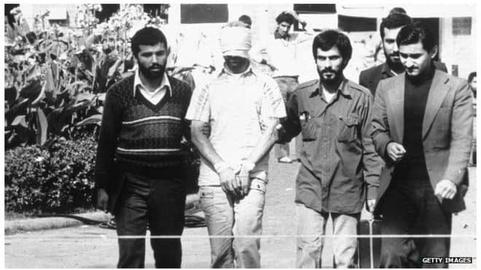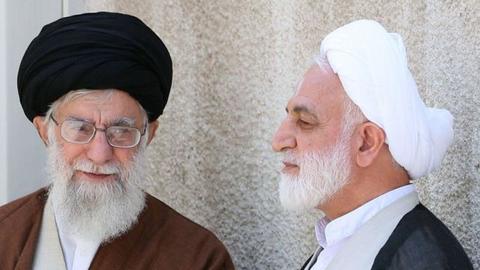Gholam Hassan Mohseni Ejei, Iran’s new judiciary chief, used to be an interrogator for the Iranian security services and was known for his particularly brutal interrogations. One prisoner, Taghi Mohammadi, who had been detained in 1986, was found dead in his jail cell a few hours after Ejei’s interrogation.
Gholamreza Moradi – a prisoner in the case of Seyyed Mehdi Hashemi, who was the brother-in-law of Ayatollah Hossein Ali Montazeri, a leading figure in the 1979 Islamic Revolution who later fell foul of the regime – had also been interrogated by Ejei and later fled while visiting family to escape further torture. Moradi’s family later said he was shot dead by security agents.
Ayatollah Fatholah Omid Najafabadi, another prisoner in this case, lost sight in an eye and hearing in an ear as a result of whipping and torture, during Ejei’s interrogations, according to his statements during meetings with family and his letters.
Taghi Mohammadi had been arrested in 1986 for his alleged role in the in the bombing of the Prime Minister's Office; the investigation and interrogations were led by Ebrahim Raisi, Iran’s new president and then the Deputy Attorney-General. The bombing place on August 30, 1981, during a meeting of the Supreme National Security Council and several top officials. Iran’s president and prime minister, Mohammad Ali Rajaei and Mohammad Javad Bahonar, as well Abdolhossein Daftarian, the prime minister's chief financial officer, and a passer-by, were all killed in the blast.
Massoud Keshmiri, the secretary of the National Security Council, was initially included in the list of those killed in the blast; but it was later revealed that he was an infiltrator of the People’s Mujahideen organization and the perpetrator of the bombing.
The prosecutor's office, in coordination with the Ministry of Foreign Affairs, summoned and arrested Taghi Mohammadi, then Iran's envoy to Afghanistan, for his alleged role in the attack.
Mohammadi was one of the students who participated in the occupation of the United States embassy in Tehran after the Revoltion. According to some reports, he was the one whose picture was published in 2005 and mistakenly said to be a photo of former president Mahmoud Ahmadinejad.
According to the documentary The Unfinished Case – which was produced to claim the complicity in the bombing of Behzad Nabavi and the leftist movement – Taghi Mohammadi was a friend of Saeed Hajarian. After the explosions, Mohammadi was sent to Afghanistan as Iran's Chargé d'Affaires. Opponents of Saeed Hajarian have also said that Mohammadi was a relative of Vajiheh Marsousi, the mother of Hajarian's wife.
Asadollah Lajevardi, the chief prosecutor, instructed Gholam Hossein Mohseni Ejei to interrogate Taghi Mohammadi. Ejei has previously said that he had interrogated Mohammadi until midnight, the day before he died, and that Mohammadi was ready to confess his connection to what was called the “hypocrisy,” in other words, the People’s Mujahideen.
Javad Mansouri, then Deputy Foreign Minister, was commissioned by the then Foreign Minister Ali Akbar Velayati to pursue the matter because Mohammadi was on the ministry staff.
"We found a piece of paper that Mr. Mohammadi had written on, with a nail, on which he wrote that because he was accused of crimes that were shameful and embarrassing to him, saying that he could not bear it, he decided to kill himself," Mansouri said.
Some figures, such as Ruhollah Hosseinian, a hardliner and senior figure in the Islamic Republic’s intelligence and security apparatus, have accused a group close to Saeed Hajarian and Behzad Nabavi of killing Taghi Mohammadi in prison. But some moderates have accused the judiciary of killing Mohammadi or of putting pressure on him that led to his suicide.
Finally, after the death of Mohammadi and the arrest of Khosro Tehrani, who was in charge of intelligence for the Prime Minister at the time of the 1981 attach, Ayatollah Ruhollah Khomeini, the founder of the Islamic Revolution and Iran’s Supreme Leader, summoned the reformist politician Abdol Karim Mousavi Ardabili, then the head of the Supreme Court, Mohammad Mousavi Khoeiniha, then the Attorney General, and ordered them to close the case.
The case of Seyed Mehdi Hashemi, the brother-in-law of Ayatollah Montazeri, in which Mohseni Ejei was the prosecutor, is meanwhile one of the few cases in which Islamic Republic officials have admitted to torturing defendants.
The defendants in this case were close to Ayatollah Montazeri, Iran’s deputy supreme leader, yet Ministry of Intelligence officials repeatedly confessed to torturing them with whips, calling it "ta'zir,” or punishment at the discretion of a jurist.
Mohammad Mohammadi Reyshahri, Minister of Intelligence at the time, has admitted in his memoirs that Mehdi Hashemi, Fathollah Omid Najafabadi and Gholamreza Moradi, all defendants in the Seyed Mehdi Hashemi case, were each flogged.
Gholamhossein Mohseni Ejei was the prosecutor's representative in the Ministry of Intelligence. He also personally interrogated Mehdi Hashemi because, in this case, the separation of responsibilities between the judiciary and the Ministry of Intelligence was not observed, even in appearance, and Ali Falahian, the then Deputy Minister of Intelligence, was also the prosecutor of the Special Clerical Court.
One of Mehdi Hashemi's relatives, who claims to have also been severely tortured, was Gholamreza Moradi, a bodyguard for Mehdi Hashemi, and was accused of killing Abbas Gholi Heshmat and also of hiding a weapon.
According to what is written in Mohammadi Reyshahri's political memoirs, Hashemi traveled from Tehran to Isfahan with the interrogators to show the exact location of ammunition he had hidden, and under the pretext of his mother's illness, he convinced the interrogators to pay a short visit to his family in Qahdarijan. But while visiting his family he tried to escape and was shot and killed by the agents.
Moradi's family reported bruises and signs of torture on his body. The Revolutionary Prosecutor's Office immediately summoned Gholamreza Moradi's father and brother, threatened them, and told them that he should be buried in an ordinary grave without informing others. But on the day of the funeral, a fierce clash took place between the slain brothers and a number of people in Qahdarijan in front of the forces of the Ministry of Intelligence. Moradi's family and the people who supported them succeeded in burying him in the martyrs’ cemetery Golzar Shohada. Reyshahri’s memoir also said that Moradi’s feet had, according to the interrogator Ejei, been bastinadoed.
A total of 40 lashes were also reportedly inflicted on Ayatollah Fathollah Omid Najafabadi's feet on several occasions. Najafabadi, a senior cleric, was held in solitary confinement for three months after his arrest. According to letters, he had even lost sight in one eye and hearing in one ear as a result of flogging and torture in prison. He was finally tried and executed in 1988 along with another cleric on charges of "immoral acts" i.e. homosexuality. Ayatollah Montazeri had said that Omid Najafabadi had fallen victim to the revelation of the McFarlane affair.
In this case, except for Mehdi Hashemi, several others were executed and 26 people were sentenced to more than 105 years in prison.
Related coverage:
Chief Justice Mohseni Ejei Signals an Even Bleaker Future for Iran Human Rights
Iran Still Haunted by its “Biggest Crime”: the 1988 Prison Massacre
Decoding Iran's Politics: The Chain Murders of Dissidents
Endemic Corruption Renders Iran’s Judiciary Ineffective and Unjust
visit the accountability section
In this section of Iran Wire, you can contact the officials and launch your campaign for various problems

























comments